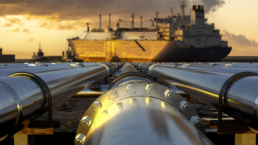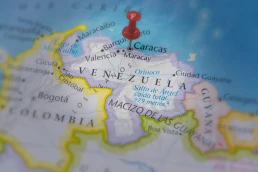The U.S. is now the world’s top exporter of LNG. Towns in southern Louisiana are paying the price.
By Lylla Younes & Jake Bittle, Grist
To visit the country’s newest hub for exporting liquefied gas to Europe, follow the Mississippi River southeast from New Orleans, past the recently shuttered Phillips 66 refinery in Alliance and deeper into Plaquemines Parish, a ribbon of land that flanks the lower Mississippi River before dropping off into the Gulf of Mexico. There, strip malls and highways give way to wide expanses of cypress and low marshes that are home to white-tailed deer, alligators, and pelicans. The border between land and water, solid ground and swamp, seems to dissolve. In this part of the Louisiana coast, most exit roads lead over levees and into wetlands traversed by local fishermen and pipeline workers. You’ll pass small fishing hamlets, clusters of trailers lining bayous, and carcasses of old houses.

Towering over this patchwork of lowland and swamp is a massive liquefied natural gas export terminal owned by the Virginia-based Venture Global LNG, one of three in Louisiana. Built on 630 acres of former swampland, an area larger than New Orleans’ French Quarter, the facility known as Plaquemines LNG extends along more than a mile of the Mississippi River. It encompasses thousands of feet of coiled steel pipes for supercooling gas, 130-foot cylindrical storage tanks, and flare stacks that expel tall, airborne flames while the plant operates. At a break in the levee wall that surrounds the property, a sign warns of the hazards inside: “WORK THE PLAN. DON’T RUSH. GET HOME SAFE.” A large metal pipe extends out of the facility and over the highway, bound for the river.
Venture Global’s terminal in Plaquemines Parish will cool natural gas down to its liquid form so it can be loaded onto ships and exported around the world. When the facility becomes operational in 2025, tanker ships will be able to plug into it and offload more than 25 million tons of natural gas each year, enough to power more than 15 million homes over the same period. The opening will represent a triumph for gas drillers that have sought to sell more of their product abroad and for President Joe Biden, who has championed American gas exports to ensure “the reliable supply of global energy” as Europe weans itself off gas imported from Russia following that country’s invasion of Ukraine.
In the 18 months since construction on Plaquemines LNG began, Venture Global has transformed the lives of people who have lived in the 23,000-person parish for generations. The streets around the plant became choked with truck traffic, the marsh threaded with pipelines, and the quiet was replaced with the din of construction. Acres of wetland disappeared beneath concrete. The broad ocean skyline of the parish vanished behind a maze of steel. And Venture Global is already working on another plant in the parish, known as Delta LNG.
“I said it would never happen, then you wake up and here it is,” said Henry McAnespy, a fisherman who grew up in the parish and lives down the road from the project. He described the roar of pipeline workers’ airboats at 6 a.m. each morning and the light pollution from the company’s round-the-clock construction. “I live in a place that never gets dark no more.”
Emboldened by a surge in global demand for natural gas, a small group of companies rushed to build an industry along the Gulf Coast, from the southern tip of Texas to southeastern Louisiana, carving up thousands of acres of vulnerable shoreline to clear the way for massive plants and send American fossil fuels overseas. Liquefaction terminals are among the most complex industrial facilities in existence, with footprints that rival those of the largest chemical plants and oil refineries; the first to open — Cheniere Energy’s plant in southwest Louisiana — encompassed an area the size of nearly 700 football fields.
Building them often requires dredging through shorelines and wetlands to build loading docks and lay hundreds of miles of pipelines. Seven of these facilities have started up in the continental United States in as many years, and at least two dozen more are in various stages of planning and construction along the Gulf Coast. A decade ago, the United States had never exported LNG, but earlier this year it became the world’s top exporter of the fuel, surpassing the gas-rich nation of Qatar.
The growth of the LNG industry in the United States has reordered world markets, offering a new energy source to Europe and Asia even as gas exports drive up domestic energy prices. But it’s on the Gulf Coast, and in particular on the rural fringes of the Louisiana coast, that the consequences of the boom have been most visible. Grist reviewed dozens of state and federal records and found that in their haste to greenlight new terminals, regulators are exposing residents of coastal parishes to new and dangerous sources of air pollution from flares and leaks. Louisiana environmental regulators recently cited numerous violations at Venture Global’s LNG terminal in Cameron Parish, but has allowed the company’s project near McAnespy’s home in Plaquemines, on the other side of the state, to move forward. And as gas exporters build their plants on eroding swampland, they are increasing the risk of catastrophic accidents and explosions during floods and hurricanes. People like McAnespy, who live in neighborhoods surrounding the terminals, are right in the blast zone.
“It’s not just that each of these facilities is like a giant death star on sinking land, it’s that there’s so many of them,” said Elizabeth Calderon, a senior attorney at the environmental nonprofit Earthjustice who has worked on cases challenging LNG terminals in south Louisiana. “This is how sacrifice zones are created.”
When John Allaire bought his 300-acre property along the Gulf of Mexico in the 1990s, the southwest coast of Louisiana was a very different place. There was no industry in sight, just wide expanses of wild grasses and wetlands leading to belts of oak trees, known as cheniers, that lined the sandy shore near the Texas state line. Since then, coastal erosion has wiped away almost all those old growth forests, and much of the landscape has been cleared for the construction of new LNG terminals like the one Venture Global built near the border of his property.
Allaire lives in Cameron Parish, a once sleepy area dotted with fishing hamlets that has transformed over the last decade into one of the world’s most important hubs for exporting natural gas. Three terminals currently operate in the 5,000-person parish; another seven are on the way. If Cameron Parish is where gas companies go to set up shop, carving out pipeline networks and erecting massive liquefaction terminals, then the city of Lake Charles an hour to the north is where they broker business deals. Long a site of petrochemical development and its accompanying pollution, Lake Charles is trying to capitalize off the prime coastal real estate to its south, with local politicians luring gas executives from Germany to Japan with events like the so-called “Americas LNG & Gas Summit & Exhibition,” which they’ve hosted two years in a row at the Golden Nugget Hotel and Casino.
Recent Posts
How To Topple Elliot Abrams’ Delusion: A Response To Elliot Abrams’s Latest Call For Regime Change In Venezuela
December 1, 2025
Take Action Now As both parties are legislating criticism of socialism, Americans’ support for Medicare For All has intensified to the point where…
A Massive Shift In Health Care Politics
December 1, 2025
Take Action Now As both parties are legislating criticism of socialism, Americans’ support for Medicare For All has intensified to the point where…
Trump’s Thanksgiving Attack on Immigrants Likened to ‘Stuff You Hear Coming Out of White Nationalists’
November 29, 2025
Take Action Now “Completely identical language,” said one observer.By Jake Johnson, Common Dreams US President Donald Trump wasted little time…
Venezuela Isn’t The Global Threat, Trump And Rubio Are
November 28, 2025
Take Action Now Will the U.S. government push forward with regime change in Venezuela?By Daniel Falcone, Foreign Policy In Focus U.S. warships and…




